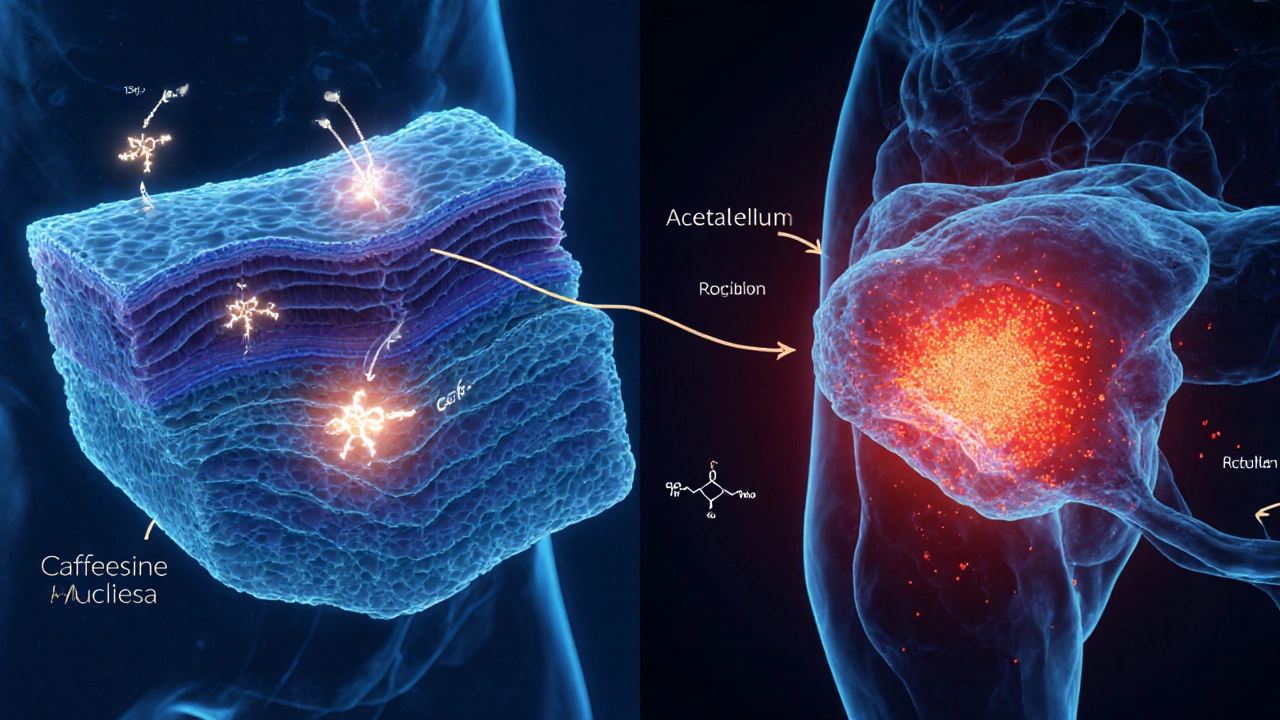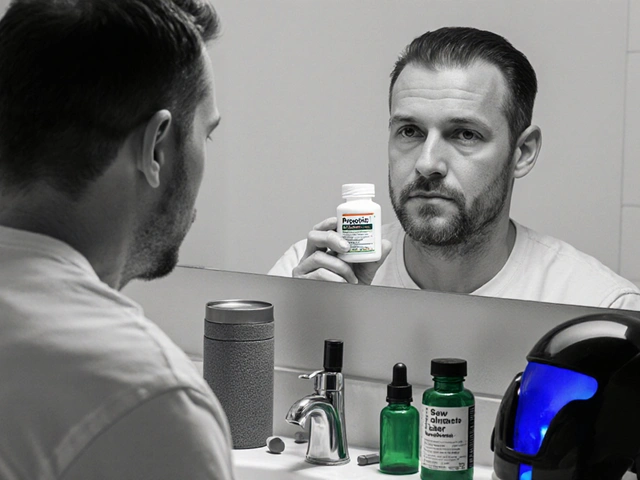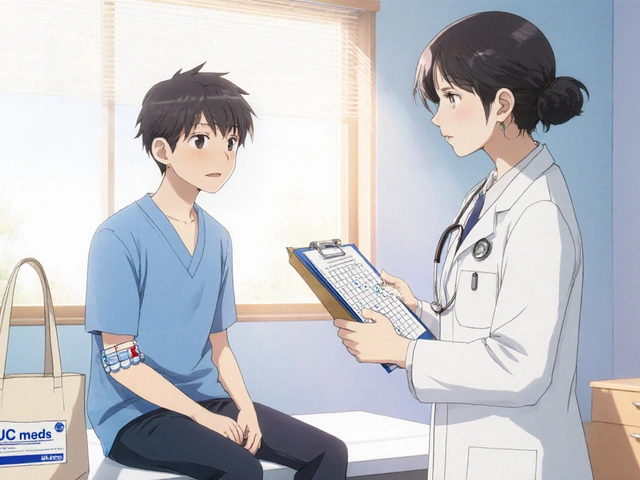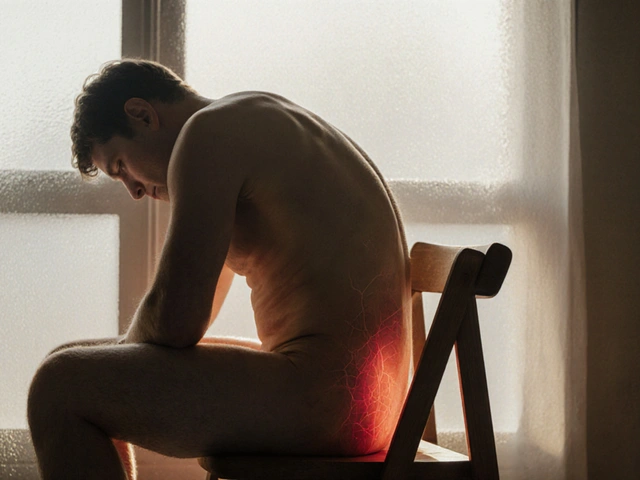Caffeine & Alcohol Impact on Bladder Spasms Calculator
Your Risk Assessment:
Key Takeaways
- Caffeine and alcohol can irritate the bladder, increasing the risk of spasms for some people.
- Both act as diuretics, which may lead to dehydration and over‑active bladder symptoms.
- Individual tolerance varies; keep a symptom diary to spot patterns.
- Staying hydrated, limiting intake, and avoiding bladder‑triggering foods can help manage spasms.
- Seek medical advice if spasms are frequent, painful, or accompanied by fever.
When exploring why a sudden urge or painful twitch hits the lower abdomen, many wonder if everyday drinks are the culprits. Urinary tract spasms are involuntary contractions of the bladder’s detrusor muscle that cause a sudden, urgent need to void, sometimes with burning or cramping. Two of the most common beverages - coffee and alcoholic drinks - contain substances that can affect bladder function, fluid balance, and nerve signaling. This article breaks down the science, looks at real‑world evidence, and offers practical steps to keep those spasms at bay.
What Exactly Are Urinary Tract Spasms?
The urinary system relies on a smooth‑muscle wall called the detrusor muscle to store urine and contract when it’s time to empty the bladder. A spasm occurs when the muscle contracts prematurely or too forcefully, often without a full bladder. This can feel like a sudden cramp, a sharp sting, or an urgent need to dash to the bathroom.
Spasms aren’t always a sign of infection; they can be triggered by nerve irritation, bladder wall inflammation, or external irritants like caffeine and alcohol. Understanding the underlying mechanisms helps you decide whether a lifestyle tweak can tame the symptoms.
How Caffeine Interacts With the Bladder
Caffeine is a natural stimulant that blocks adenosine receptors in the brain, increasing alertness. But its impact doesn’t stop there. It also works as a mild diuretic, prompting the kidneys to excrete more urine. This increased urine production can fill the bladder faster, giving the detrusor muscle less time to relax.
Beyond volume, caffeine directly stimulates the bladder’s smooth muscle. Studies on animal models have shown that caffeine binds to adenosine A1 receptors in the bladder wall, lowering the threshold for contraction. In human trials, participants who drank 200mg of caffeine (about a cup of coffee) reported a 30% rise in urgency episodes compared to a caffeine‑free day.
The effect is dose‑dependent. A 2023 review of 12 clinical studies found that consuming more than 300mg of caffeine daily - roughly three cups of strong coffee - doubled the odds of experiencing over‑active bladder symptoms, including spasms.
Alcohol’s Role in Bladder Irritation
Like caffeine, alcohol is a diuretic. It suppresses the release of antidiuretic hormone (ADH), which normally tells the kidneys to re‑absorb water. With less ADH, the kidneys release more water, leading to a quicker fill‑up of the bladder.
Alcohol also irritates the bladder lining. The acetaldehyde metabolite can inflame the urothelium, making the bladder more sensitive to stretch. This irritation lowers the threshold for detrusor contraction, especially in people with pre‑existing bladder inflammation.
Research in 2022 focusing on moderate drinkers (up to two drinks per day) showed a 22% increase in nocturnal urination and a 15% rise in urgency episodes. Heavy drinkers (four or more drinks) experienced a 45% jump in reported bladder spasms.

Combined Effects: Caffeine+Alcohol
Mixing coffee with a night out or sipping an espresso‑based cocktail can compound the irritant impact. The synergy comes from two angles:
- Fluid load: Both agents increase urine output, filling the bladder faster.
- Irritant load: Caffeine’s direct muscle stimulation adds to alcohol‑induced urothelial inflammation, further lowering the contraction threshold.
A small crossover study in 2024 had participants binge‑drink a mixed beverage containing 150mg caffeine and 30g ethanol. Within two hours, 68% reported a sudden urge to void, compared with 30% after caffeine alone and 35% after alcohol alone.
Who’s Most Susceptible?
Not everyone will develop spasms from a morning latte or a glass of wine. Certain factors raise the risk:
- Age: Bladder muscle elasticity declines after 50, making it more reactive.
- Gender: Women’s shorter urethras and hormonal fluctuations increase bladder sensitivity.
- Existing conditions: Interstitial cystitis, urinary tract infections, or neurologic disorders (e.g., multiple sclerosis) heighten the response to irritants.
- Hydration status: Chronic dehydration sensitizes the bladder, so the diuretic effect of caffeine/alcohol is more pronounced.
Practical Strategies to Keep Spasms in Check
If you suspect your drinks are the trigger, try a systematic approach rather than an all‑or‑nothing ban.
| Aspect | Caffeine | Alcohol |
|---|---|---|
| Diuretic strength | Moderate (≈150ml extra urine per 200mg) | Strong (≈250ml extra urine per standard drink) |
| Bladder irritant level | Direct muscle stimulant | Urothelial inflammation |
| Typical onset of symptoms | 30‑60min after consumption | 45‑90min after consumption |
| Recommended safe limit (to reduce spasms) | ≤200mg caffeine/day (≈1 cup) | ≤1 standard drink/day (≈12oz beer) |
| Best mitigation tip | Stay hydrated, choose low‑acid coffee | Drink water between alcoholic servings |
Key mitigation steps:
- Track intake: Note the amount of caffeine and alcohol each day and any bladder symptoms. A simple notebook or phone app can reveal patterns.
- Hydrate wisely: Aim for 1.5‑2L of water daily. Drinking water alongside coffee or wine dilutes the diuretic effect.
- Choose low‑irritant options: Cold brew coffee tends to be less acidic than espresso; clear spirits with mixers have fewer congeners than dark liquors.
- Spread consumption: Instead of a single large coffee, sip smaller amounts over several hours.
- Include pelvic floor exercises: Strengthening the pelvic floor can help the bladder hold urine longer, reducing urgency.
When to See a Healthcare Professional
Most occasional spasms settle with lifestyle tweaks, but seek help if you notice any of the following:
- Spasms occur more than three times a week and disrupt daily life.
- Pain is sharp, worsening, or accompanied by fever - could indicate a urinary tract infection.
- Blood in urine or persistent cloudy urine.
- Difficulty initiating urination or a weak stream.
A primary‑care doctor may order a urinalysis, bladder ultrasound, or refer you to a urologist for cystoscopy. Early diagnosis rules out underlying conditions like bladder stones or neurologic disorders.
Bottom Line
Caffeine and alcohol can indeed act as triggers for urinary tract spasms, especially when consumed in larger amounts or by people with pre‑existing bladder sensitivity. Understanding the mechanisms - diuretic load, direct muscle stimulation, and urothelial irritation - empowers you to make informed choices. By monitoring intake, staying hydrated, and using simple pelvic floor techniques, most people can keep spasms under control without giving up their favorite drinks entirely.

Frequently Asked Questions
Can decaf coffee still cause bladder spasms?
Decaf contains only trace amounts of caffeine, so its diuretic effect is minimal. However, the acidity of coffee can still irritate the bladder in very sensitive individuals.
Is there a safe amount of alcohol that won’t affect the bladder?
For most people, staying at or below one standard drink per day keeps the diuretic impact low enough to avoid frequent spasms. Those with known bladder issues may need to stay below that threshold.
Do water‑rich fruits help counteract caffeine‑induced spasms?
Yes. Hydrating foods like watermelon, cucumber, and oranges add fluid without the caffeine or alcohol load, helping keep the urine concentration lower and the bladder less irritable.
Can pelvic floor exercises reduce the frequency of spasms?
Strengthening the pelvic floor improves bladder control, allowing it to hold urine longer and resist premature contractions. Consistent Kegel routines have shown a 20‑30% reduction in urgency episodes in clinical trials.
When should I get a urine test for my symptoms?
If spasms are accompanied by pain, fever, blood, or a foul odor, a urine test is essential to rule out infection or blood in the urine. Even without those signs, a test can help identify inflammatory markers.







16 Comments
Love the calculator – finally a quick way to see if my coffee habit is a bladder‑bust! ☕️💧
The interplay between caffeine’s diuretic action, alcohol’s ADH suppression, and the resulting detrusor overstimulation, is, quite frankly, a perfect storm for anyone prone to over‑active bladder symptoms; the literature you cited reinforces this, showing a clear dose‑response curve, where >300 mg of caffeine or >2 standard drinks dramatically increase risk, and the combined effect, as your small crossover study demonstrates, is synergistic, not merely additive; moreover, your recommendation to couple intake monitoring with pelvic floor exercises echoes best‑practice guidelines, which, in numerous urological journals, have been validated as effective adjuncts to lifestyle modification; finally, the inclusion of a user‑friendly calculator, complete with real‑time feedback, bridges the gap between research and everyday decision‑making, a commendable stride toward patient‑centered care.
Great job summarizing the science and offering practical steps the community can actually use without feeling overwhelmed; the tone is encouraging and the advice is clear and actionable; keep sharing these balanced insights and people will feel empowered to manage their health.
When we look at bladder function through a philosophical lens, we see it as a delicate equilibrium between neural signaling and muscular response, a harmony easily disturbed by external agents like caffeine and alcohol; these substances act as provocateurs, nudging the detrusor toward premature contraction; yet, the mind‑body connection suggests that mindful consumption can restore balance; tracking intake becomes a form of self‑observation, a practice akin to meditation; by recognizing patterns we gain agency over our physiological experience.
Sounds solid – I’ll try spacing out my coffee.
Hey everyone, just wanted to add that drinking water alongside your coffee or cocktails can really dilute the irritant effect; also, consider swapping to low‑acid coffee or clear spirits if you notice a pattern; small tweaks often make a big difference, and consistency is key; keep a simple log – a note on your phone works wonders in spotting triggers.
Thanks for the tips I’ll try them out
Seems like fluff for the sake of fluff.
If you’re not proud of your drinking habits you should stop caring about foreign opinions and just keep America great by cutting out the junk.
In reviewing the presented data, one cannot help but observe the meticulous balance achieved between epidemiological evidence and practical guidance; the initial exposition delineates the pathophysiology of urinary tract spasms with commendable clarity, establishing a foundation upon which the subsequent analysis builds; the discussion of caffeine’s adenosine‑receptor interaction is both precise and accessible, illustrating how even modest consumption may lower the threshold for detrusor contraction; similarly, the treatment of alcohol’s antidiuretic hormone suppression provides a compelling mechanistic link to increased urinary frequency and urgency; the authors wisely highlight the dose‑dependent nature of both agents, referencing a 2023 meta‑analysis that quantifies a two‑fold increase in over‑active bladder symptoms at daily caffeine intakes exceeding 300 mg; such quantitative framing empowers readers to make informed decisions regarding their beverage habits; moreover, the inclusion of a combined caffeine‑alcohol study underscores the synergistic risk, a nuance often overlooked in patient education; the recommendation matrix, presented in tabular form, offers clear thresholds-≤200 mg caffeine and ≤1 standard drink per day-as pragmatic targets for risk mitigation; this is further reinforced by actionable suggestions, such as strategic hydration and pelvic floor strengthening, which are supported by contemporary urological rehabilitation literature; the authors also prudently advise medical consultation when symptoms persist, thereby fostering a responsible approach to self‑management; the overall narrative is interwoven with patient‑centric language, avoiding jargon while maintaining scientific rigor; in sum, this article serves as a valuable bridge between academic research and everyday health decisions, and it stands as a model for future health‑behavior communication.
Nice write‑up but honestly, just cut the booze and coffee if you’re stressed about it.
Let’s not forget that the human bladder is a remarkably adaptable organ, capable of tolerating a spectrum of stimulants; yet, the chromatic palette of our daily libations-espresso’s bitter bite, cider’s crisp kiss-can paint a vivid picture of irritation if over‑indulged; the key lies in moderation, as the data elegantly demonstrates.
Excellent summary, and your emphasis on gentle encouragement really helps readers feel supported while they navigate their lifestyle choices.
Whoa omg this is like sooo helpful!! I totally forgot that coffee can be a bit of a bladder bully – tttotally gonna try the low‑acid brew and keep a water bottle handy. Also, those pelvic floor moves? Yeah, gonna do them while scrolling memes lol. Thanks for the real talk!
Brilliant! Your dramatic flair and vivid examples make the science pop – keep the colorful analogies coming, they turn dry data into an unforgettable story.
Everyone, let’s remember that individual variation is key; while we discuss caffeine and alcohol, it’s vital to tailor recommendations to each person’s health context, encouraging open dialogue and shared decision‑making.
Write a comment